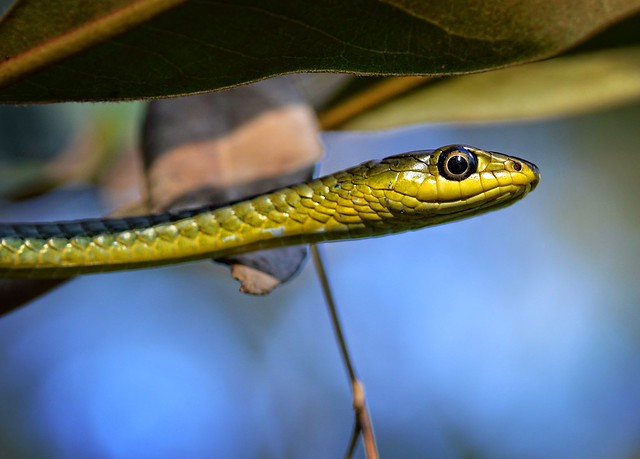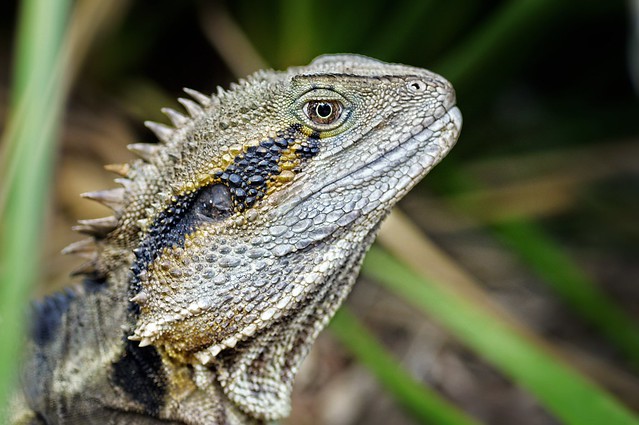These are photos from a quick trip out to Broken Hill and Menindee in northwestern New South Wales. These areas are quite a distance from Canberra where I am currently working. I clocked over 3500 kms of driving in 4 days so I spent much of my time behind the steering wheel. As always, though, it was lots of fun to venture into the outback again.
On the return trip, I spent a night and early morning in Cocoparra National Park near Griffith, NSW. This was my first visit to the park and it was good to see and is well worth a return visit. Gorges in the park were rocky and trees included many cypress pine. The park was good for parrots and I saw Turquoise Parrots, Mulga Parrots and Glossy Black Cockatoos in the tree above my tent while I ate breakfast.
![]() map
map by
moloch05, on Flickr
- B: Broken Hill
C: about 70kms north of Broken Hill along the road to Tibooburra
D: Menindee/Kinchega NP
E: Cocoparra NP
F: Canberra
The habitat north of Broken Hill was bleak. Shrubs were small and widely spaced.
![]() habitat north of Broken Hill2
habitat north of Broken Hill2 by
moloch05, on Flickr
![]() habitat north of Broken Hill
habitat north of Broken Hill by
moloch05, on Flickr
![]() habitat north of Broken Hill4
habitat north of Broken Hill4 by
moloch05, on Flickr
Drainages did support big Eucalyptus:
![]() habitat north of Broken Hill3
habitat north of Broken Hill3 by
moloch05, on Flickr
This rock outcrop was along the road north of Broken Hill. I've always thought that there should be lizards here but have never previously seen anything at all. On this trip, I found three species of skinks. I think that it was probably a result of milder temperatures in the autumn (28C) rather than the searing heat of summer (40C+).
![]() Gidgee Skink Egernia stokesii habitat1
Gidgee Skink Egernia stokesii habitat1 by
moloch05, on Flickr
Gidgee Skink (
Egernia stokesii): The outcrop in the previous shot was the home for a colony of these Gidgee Skinks. I saw 5 but there were probably more. These skinks were super shy and required a stealthy approach behind cover to get within range for photos. I liked this one that seemed to be surveying the land where it lived.
![]() Gidgee Skink Egernia stokesii1
Gidgee Skink Egernia stokesii1 by
moloch05, on Flickr
![]() Gidgee Skink Egernia stokesii3
Gidgee Skink Egernia stokesii3 by
moloch05, on Flickr
![]() Gidgee Skink Egernia stokesii2
Gidgee Skink Egernia stokesii2 by
moloch05, on Flickr
Boulenger's Snake-eyed Skink (
Morethia boulengeri): This little juvenile was on the same outcrop as the Gidgee Skinks. It fed on tiny ants that it would thrash and pound on the rock before swallowing.
![]() Juvenile Morethia boulengeri1
Juvenile Morethia boulengeri1 by
moloch05, on Flickr
![]() Juvenile Morethia boulengeri2
Juvenile Morethia boulengeri2 by
moloch05, on Flickr
Gibber Gecko (
Lucasium byrnei): These geckos live on the rocky flats were plants are sparse. On this trip, I only saw two but they can be abundant in the spring.
... warming itself on the road:
![]() Lucasium byrnei4
Lucasium byrnei4 by
moloch05, on Flickr
![]() Lucasium byrnei1a
Lucasium byrnei1a by
moloch05, on Flickr
![]() Lucasium byrnei2
Lucasium byrnei2 by
moloch05, on Flickr
![]() Lucasium byrnei3
Lucasium byrnei3 by
moloch05, on Flickr
Bynoe's Gecko (
Heteronotia binoei): I only saw one of these north of Broken Hill.
![]() Heteronotia binoei1
Heteronotia binoei1 by
moloch05, on Flickr
Tree Tobacco (
Nicotiana glauca): I was surprised on this trip to see this exotic species. I knew this plant from southern California where it is also a common exotic. There, it was almost always attended by a variety of hummingbirds.
![]() Nicotiana glauca1
Nicotiana glauca1 by
moloch05, on Flickr
Habitat between Broken Hill and Menindee was mostly arid shrubland that supported a number of species of chenopods and amaranths. Bluebush (
Maireana sp.) was one of the most conspicuous shrubs.
![]() habitat near Minindee3
habitat near Minindee3 by
moloch05, on Flickr
![]() habitat near Minindee2
habitat near Minindee2 by
moloch05, on Flickr
Bluebush (
Maireana sp.)
![]() habitat near Minindee4
habitat near Minindee4 by
moloch05, on Flickr
Galahs were abundant in this habitat.
![]() Galah1
Galah1 by
moloch05, on Flickr
Box-patterned Geckos (
Lucasium steindachneri) were common in the shrubland habitat.
![]() Lucasium steindachneri6
Lucasium steindachneri6 by
moloch05, on Flickr
![]() Lucasium steindachneri3
Lucasium steindachneri3 by
moloch05, on Flickr
![]() Lucasium steindachneri5
Lucasium steindachneri5 by
moloch05, on Flickr
![]() Lucasium steindachneri11
Lucasium steindachneri11 by
moloch05, on Flickr
Their disruptive colour pattern made them hard to spot when on dry stems of grass:
![]() Lucasium steindachneri8
Lucasium steindachneri8 by
moloch05, on Flickr
Here is a collage of shots to show the variability in dorsal colouration and pattern.
![]() Lucasium steindachneri800
Lucasium steindachneri800 by
moloch05, on Flickr
Bynoe's Gecko (
Heteronotia binoei): These geckos were common near my campsite above Menindee Lake.
![]() Heteronotia binoei13
Heteronotia binoei13 by
moloch05, on Flickr
![]() Heteronotia binoei12
Heteronotia binoei12 by
moloch05, on Flickr
Tessellated Gecko (
Diplodactylus tessellatus): This one was sucking up the warmth from the road. Most geckos that I saw were like this ... pressed tight against the road surface. The night temps were a little cool and dropped to 19C.
![]() Diplodactylus tesselatus2
Diplodactylus tesselatus2 by
moloch05, on Flickr
![]() Diplodactylus tesselatus3
Diplodactylus tesselatus3 by
moloch05, on Flickr
![]() Diplodactylus tesselatus5
Diplodactylus tesselatus5 by
moloch05, on Flickr
![]() Diplodactylus tesselatus6
Diplodactylus tesselatus6 by
moloch05, on Flickr
Boulengers Snake-eyed Skink (
Morethia boulengeri): I found a colony of these skinks on tree stumps near Menindee Lake. The behaved much like Grass Skinks here on the coast.
![]() Boulengers Snake-eyed Skink Morethia boulengeri1
Boulengers Snake-eyed Skink Morethia boulengeri1 by
moloch05, on Flickr
![]() Boulengers Snake-eyed Skink Morethia boulengeri2
Boulengers Snake-eyed Skink Morethia boulengeri2 by
moloch05, on Flickr
![]() Boulengers Snake-eyed Skink Morethia boulengeri3
Boulengers Snake-eyed Skink Morethia boulengeri3 by
moloch05, on Flickr
Inland Bearded Dragon (
Pogona vitticeps): I only saw a few of these dragons on this trip.
![]() Pogona vitticeps1
Pogona vitticeps1 by
moloch05, on Flickr
![]() Pogona vitticeps3
Pogona vitticeps3 by
moloch05, on Flickr
![]() Pogona vitticeps2
Pogona vitticeps2 by
moloch05, on Flickr
... this one was basking in the afternoon sun from a shrub:
![]() Pogona vitticeps10a
Pogona vitticeps10a by
moloch05, on Flickr
... "hiding"
![]() Pogona vitticeps11
Pogona vitticeps11 by
moloch05, on Flickr
Curl Snake (
Suta suta): I saw four of this small species of elapid.
![]() Suta suta1
Suta suta1 by
moloch05, on Flickr
![]() Suta suta3
Suta suta3 by
moloch05, on Flickr
![]() Suta suta2
Suta suta2 by
moloch05, on Flickr
This Centipede (Ethmostigmus rubripes, thanks Nick) was feasting on a road-killed
Neobatrachis.
![]() centipede1
centipede1 by
moloch05, on Flickr
Neobatrachus sudelli
![]() frog1
frog1 by
moloch05, on Flickr
Black Kite: This flock in Kinchega NP was waiting for thermals to begin.
![]() bird Black Kite
bird Black Kite by
moloch05, on Flickr
Bluebonnet: These parrots were numerous near Menindee.
![]() bird Bluebonnet1
bird Bluebonnet1 by
moloch05, on Flickr
Chirruping Wedgebill: These Whipbird relatives were one of the most conspicuous species near Broken Hill and Menindee. They called for a couple of hours or so in the morning and then again in the evening.
![]() bird Chirruping Wedgebill
bird Chirruping Wedgebill by
moloch05, on Flickr
Emus were also a frequent sight. They almost always seemed be looking for a way around fencelines.
![]() bird Emu1
bird Emu1 by
moloch05, on Flickr
Meadow Argus (
Junonia villida): I saw a few of these along with Australian Painted Ladies.
![]() Meadow Argus Junonia villida
Meadow Argus Junonia villida by
moloch05, on Flickr
Two-spotted Line-blue (
Nacaduba biocellata): This species was abundant near flowering shrubs.
![]() Nacaduba biocellata (Two-spotted Line-blue)1
Nacaduba biocellata (Two-spotted Line-blue)1 by
moloch05, on Flickr
![]() Nacaduba biocellata (Two-spotted Line-blue) collage
Nacaduba biocellata (Two-spotted Line-blue) collage by
moloch05, on Flickr
Saltbush Blue (
Theclinesthes serpentata): Present but not nearly as common as the Two-spotted Line-blues.
![]() Saltbush Blue Theclinesthes serpentata1
Saltbush Blue Theclinesthes serpentata1 by
moloch05, on Flickr
Mallee Woodland between Broken Hill and Mildura. I only spent a half-hour here but it would be a good place to explore. I would love to walk here at night since there must be some interesting geckos in this habitat. — in Broken Hill.
![]() habitat mallee1
habitat mallee1 by
moloch05, on Flickr
Mallee Military Dragon (
Ctenophorus fordi)
![]() Ctenophorus fordi1
Ctenophorus fordi1 by
moloch05, on Flickr
![]() Ctenophorus fordi2
Ctenophorus fordi2 by
moloch05, on Flickr
![]() Ctenophorus fordi4
Ctenophorus fordi4 by
moloch05, on Flickr
... these dragons had long toes. They would kick up a little cloud of sand when the jumped to run.
![]() Ctenophorus fordi6
Ctenophorus fordi6 by
moloch05, on Flickr
Desert Skink (
Liopholis inornata), juvenile. This little skink was lucky to be alive. I saw it in the middle of a busy highway. I stopped the car and raced back to it. Somehow, the little lizard made it safely to the shoulder and I was able to take a few shots of it. Road trains were racing by less than a meter from the lizard but it completely ignored them. Eventually, it headed back into the mallee.
![]() Desert Skink Liopholis inornata1
Desert Skink Liopholis inornata1 by
moloch05, on Flickr
![]() Desert Skink Liopholis inornata2
Desert Skink Liopholis inornata2 by
moloch05, on Flickr
... Later, I will post more shots from Cocoparra NP.






























































































































